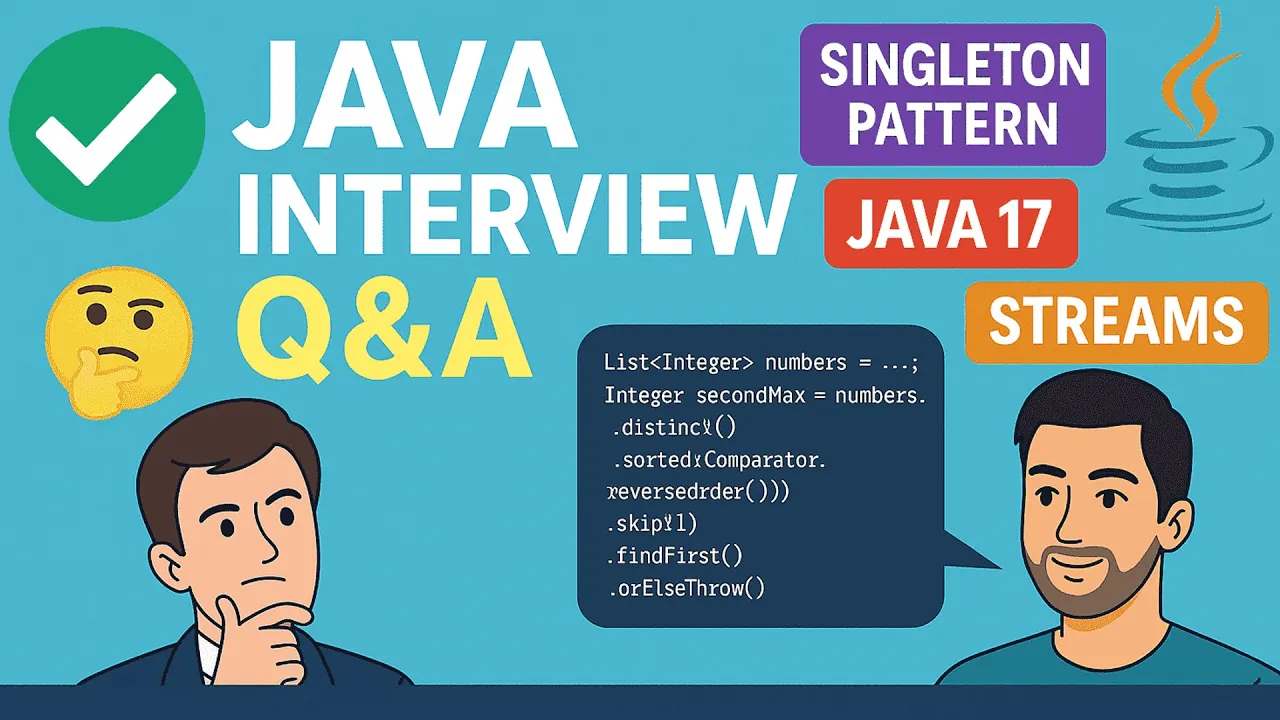1. How to get employees from a list of employees who are 30 years old and more using streams
List<Employee> filtered = employees.stream()
.filter(emp -> emp.getAge() >= 30)
.collect(Collectors.toList());
2. What is a Future variable in concurrency?
Future represents the result of an asynchronous computation. It provides methods to check if the computation is complete, wait for its completion, and retrieve the result.
ExecutorService service = Executors.newSingleThreadExecutor();
Future<Integer> future = service.submit(() -> 5 + 5);
3. What is an Optional?
Optional is a container object used to represent the presence or absence of a value, introduced in Java 8 to avoid NullPointerException.
Optional<String> optional = Optional.ofNullable(getName());
4. What is a Serializable interface? Why is it used?
Serializable is a marker interface (no methods) used to allow objects to be converted into a byte stream. This is essential for saving objects to files or sending them over a network.
5. What is the relation of equals and hashCode method?
- If two objects are equal (
equals()returns true), then theirhashCode()must be the same. - If two objects are not equal, their
hashCode()may or may not be the same.
6. What is try-with-resources? Which classes are applicable for it?
try-with-resources is used to auto-close resources that implement AutoCloseable or Closeable.
try (BufferedReader reader = new BufferedReader(new FileReader("file.txt"))) {
System.out.println(reader.readLine());
}
7. How to create a Singleton class
public class Singleton {
private static Singleton instance;
private Singleton() {}
public static synchronized Singleton getInstance() {
if (instance == null) {
instance = new Singleton();
}
return instance;
}
}
8. Which exception is prevented by ConcurrentHashMap?
ConcurrentModificationException is avoided in ConcurrentHashMap as it is thread-safe and does not throw this during concurrent access.
9. How to autowire an interface that has two implementations?
Use @Qualifier annotation to distinguish between implementations.
@Autowired
@Qualifier("impl1")
private MyInterface myInterface;
10. List the annotations used in storing an employee's details from Postman to DB using Spring Data JPA
@RestController@PostMapping@RequestBody@Valid@Entity@Table@Id@GeneratedValue@Column@Autowired@Repository@Service
11. Difference between @Valid used in Entity class vs Controller class
- In Entity class, annotations are used to define validation rules (e.g.,
@NotNull,@Size). - In Controller class,
@Validtriggers the validation rules defined in the entity.
12. How to create an annotation
@Retention(RetentionPolicy.RUNTIME)
@Target(ElementType.METHOD)
public @interface MyAnnotation {
String value();
}
13. What is externalization of configuration?
It means keeping configuration data outside the codebase (e.g., application.properties, YAML files) to make the application configurable without modifying the source code.
14. What are some entity class annotations?
@Entity@Table@Id@GeneratedValue@Column@OneToMany,@ManyToOne, etc.
15. How is a composite key mapped in Hibernate?
Use @Embeddable and @EmbeddedId.
@Embeddable
public class EmployeeId implements Serializable {
private Long empId;
private String deptCode;
}
@Entity
public class Employee {
@EmbeddedId
private EmployeeId id;
}
16. What are some annotations from JUnit?
@Test@BeforeEach,@BeforeAll@AfterEach,@AfterAll@Disabled@DisplayName@Nested
17. Why does a functional interface have only one method?
To allow lambda expressions to work. A lambda must implement exactly one abstract method, so functional interfaces are restricted to one.
18. What is ExecutorService?
ExecutorService is part of the java.util.concurrent package. It manages and controls thread execution using a thread pool.
ExecutorService executor = Executors.newFixedThreadPool(2);
executor.submit(() -> System.out.println("Task"));
executor.shutdown();
